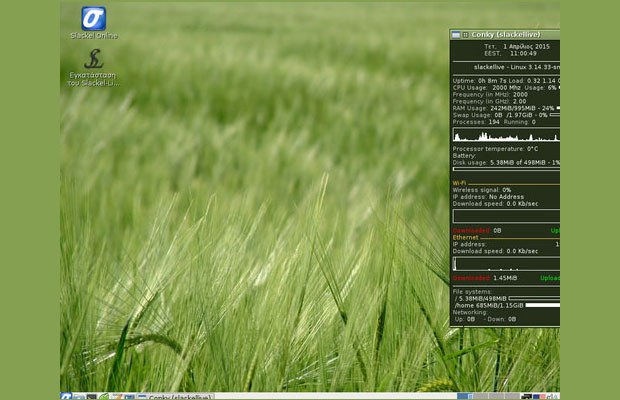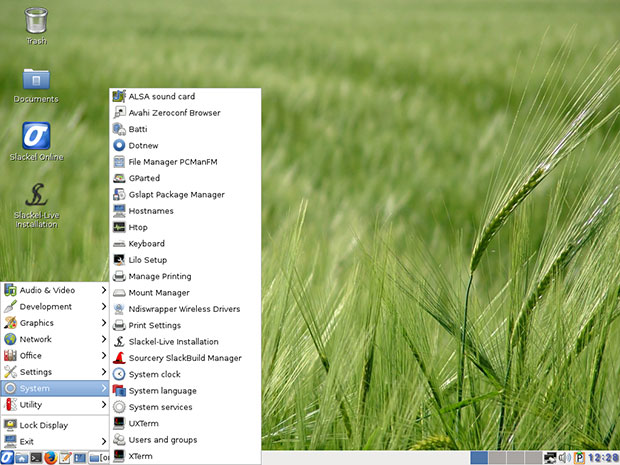
![]()
Slackel is a Linux distro a step away from the mainstream Debian-based Linux OS line. It is based on Slackware and Salix. Users already familiar with that lineage are more inclined to like Slackel. Slackel offers a few advantages not usually found with the Slackware Linux lineup. Slackel is fully compatible with Slackware and Salix. The main difference is that it includes the current version of Slackware and the latest version of KDE in the repository.
That gives Slackel a better reach for adding software. Slackware-based distros typically have far smaller software repositories than Debian-based distros and others. Think in terms of a few thousand packages compared to 35,000.

So finding Linux packages that will run in Slackel is less of a challenge, but you still will experience slimmer pickings.
Another factor to consider is the office suite. Users unfamiliar with the less standard office application Calligra that’s preinstalled in Slackel can opt for the LibreOffice suite in the Slackel repositories.
Perhaps the best improvement in Slackel as a Slackware-based choice is the system tools. All the Salix system tools are present to make system administration easy and straightforward. The Salix codecs installer application quickly and easily installs patent-encumbered codecs.
Under the Hood
Slackel is a distribution from developer Dimitris Tzemos. It ships with version 3.18.11 of the Linux kernel and offers support for 32-bit and 64-bit x86 machines.
The 64-bit ISO supports booting on UEFI systems, but Safe Boot is not supported. Slackel KDE 4.14.3 was released Aug. 8. The Slackel disc images come in two forms: installation and live.
The 32-bit flavor supports both i686 PAE SMP and i486 non-PAE-capable systems. Slackel comes with the latest version of the KDE desktop. Current releases also offer slightly older versions of Openbox and Fluxbox.


A very cool feature is Slackel’s ability to provide persistent memory from running in live session. Setting that up from a DVD boot is not without some work, but it does function. A better approach is to transfer the ISO to a USB storage device.
Either way, you can actually use Slackel productively without doing a full hard drive installation. The website has a full set of directions for installation options.
To transfer the ISO to a USB stick, be sure you read theinstructions here. If you use the dd command to write the iso to a USB location, some features like persistence will not be available.
Software Supplied
Slackel Live KDE includes the current tree of Slackware and KDE 4.14.3 accompanied by a collection of KDE software. Firefox 38.0.1esr is the Web browser. KMail and KTorrent are the main networking applications included in this release.
Also included are the RSS reader for KDE — Akregator and Kopete, the KDE instant messenger application. Other preinstalled packages include Openjre-7u79, Rhino, IcedTea-web and Gparted. Wicd is used for setting up wired and wireless networking connections.
Multimedia packages are few but functional. The Dragon multimedia player, Clementine 1.2.3 and K3b 2.0.2 are included. In the graphics section, you’ll find Gwenview, KColorChooser and KSnapshot.
For a Slackware-based distro, one of Slackel’s strong points is the systems tool collection from Salix Linux. Slackel uses the Gslapt Package Manager for access to Slackware, Salix and Slackel package repositories.
Sourcery provides an easy way to interface with the SlackBuilds.org and the package building scripts that it offers. Package update notifications are handled by the Salix Update Notifier application.
Installer Options
The latest Slackel KDE release is available from SourceForgehere. The root password is the word “live.” The standard user login is the word “one” with no password required.
You can install Slackel using one of three installation modes. Full mode installs everything included in the installation medium. A Basic mode installation includes only the basic packages that make up the KDE desktop environment, the collection of Salix System Tools and the Firefox browser. Core mode installs a command line-based system without any graphical environment.
The Slackel Live Installer handles putting the Slackel Live KDE operating system from within a running live system on your hard drive or on a USB stick. SLI now supports Lilo or Grub boot loaders. You can manage partitions through the installer using Gparted and also set a password for root and create a new user with password for the installed system.
Slackel Primer
You might think of the Slackel distro as a better Slackware derivative. Slackware dates back to 1992. By comparison, well-known and well-used distros such as Ubuntu, Fedora and Linux Mint were introduced in the mid-2000s. So Slackware is among the oldest actively maintained Linux distros.
Despite its longevity, it has not joined more modern Linux offspring in terms of user friendliness. The Slackware project started as a way to install a Linux system that already included some core packages like the kernel and an X window system.
In its long run, Slackware has updated but not improved much. It is still not easy to set up and use compared to more modern Linux distro replacements.
You see this right up front when you install software. Slackware distros typically force you to find and install the software on your own. The process includes creating Slackware packages, using tools to convert .rpm and .deb files, or compiling the code yourself.
You can install Slackware packages with the upgradepkg command. This does nothing more than install a package and keep track of those installed, however. It does nothing about resolving dependencies or conflicts or performing other features.
Bottom Line
Slackel changes the software management dilemma at least somewhat. Slackel — or any other Slackware-based distro — is not a good choice for new users looking to make a fast move into a Linux OS.
That said, Slackel has some benefits. As you learn to use it, you get closer to understanding the pure Linux environment. Plus, you have a system made your way because you decide what gets installed.
The KDE desktop is a good choice over the Fluxbox and Openbox desktop choices. It gives users much more flexibility and control within the Slackware environment.
Want to Suggest a Review?
Is there a Linux software application or distro you’d like to suggest for review? Something you love or would like to get to know?
Please email your ideas to me, and I’ll consider them for a future Linux Picks and Pans column.
And use the Talkback feature below to add your comments!




















































